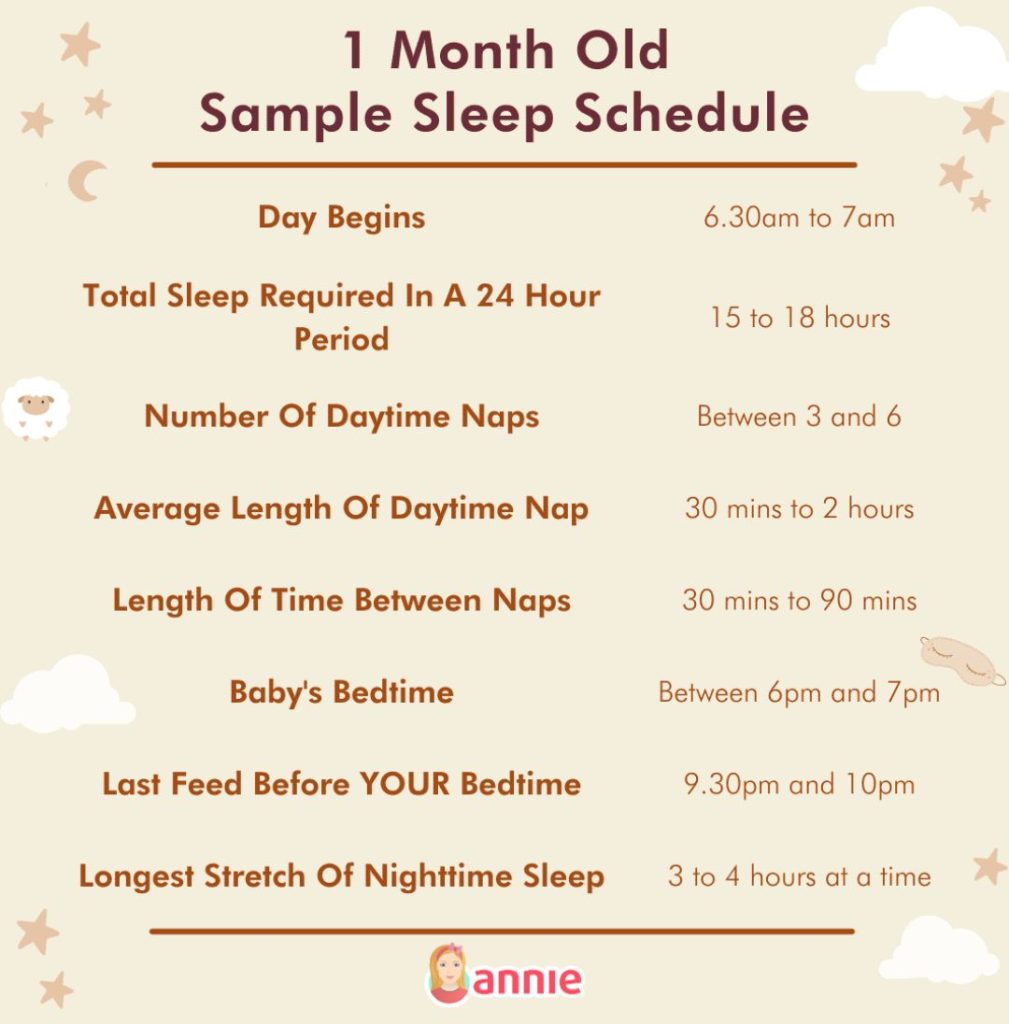
Navigating Infant Sleep Patterns: How To Create a 1-Month-Old Sleep Schedule
- Created:
6. 11. 2023 - Updated:
9. 11. 2023
Let’s face it:
Babies aren’t born with predictable or organized sleep cycles.
So:
The first month of a baby’s life can be hard on parents because of their newborn’s fluctuating sleep patterns.
Thankfully:
With a 1-month sleep schedule, you can navigate your infant’s sleep through this phase and ensure they’re safe and comfortable.
With that said:
Join us as we discuss the importance of a 1-month old sleep schedule and how to create one.
Let’s get into it!
The Importance of Sleep for a 1-Month-Old
Fact:
The benefits of sleep for 1-month-olds go further than helping their bodies rest. It aids their physical development, helps them to process new skills, and enables them to adjust to patterns.
To this effect:
Let’s discuss some of the benefits of sleep for a 1-month-old:
- Brain Development: Sleep is quite important for a 1-month-old baby’s brain development. It impacts alertness, emotional regulation, cognitive performance, learning, and memory.
- Immune System Support: The immune system releases special proteins called cytokines when we sleep, promoting our overall well-being. In infants, cytokines are highly essential because they help to fight infections and ensure your baby stays healthy.
- Increased Physical Growth: When babies are in deep slumber, their bodies release human growth hormones (HGH). These hormones are connected to their height, body mass, and bone density, which impacts growth.
In all, from the first night they spend at home, babies spend a lot of time sleeping.
According to The Sleep Foundation, babies under four months typically spend 16-18 hours sleeping daily. But of course, they don’t sleep for 18 hours at a stretch.
Rather, the baby can spend short bursts of 20-30 minutes asleep during certain periods of the day.
Identifying Sleep Windows
For starters:
Before you can identify your baby’s sleep windows, you must first understand what a sleep window is.
So, let’s break it down.
A sleep window is the period in which the body naturally wants to go to sleep.
In other words:
It’s the period when the baby’s brain expects sleep. This period can change with age, but keeping track of it can help you ensure your baby gets the amount of sleep they need.
Now check this out:
A good sleep routine has a positive impact on your baby’s overall health.
So:
If you happen to find your bundle of joy in their sleep window, it is good news for you and the baby!
On one hand, your baby gets their beauty sleep, and on the other, you can get the recess you need.
Moving forward:
To identify your baby’s sleep windows, there are some signs that tell you that they’re ready to hit the bed. Below are some tips for identifying your 1-month-old’s sleep windows:
- Watch out for slower motor activity or mobility
- Listen to notice their reduced babbling, cooing, or noises
- Pay attention to catch their eyelids drooping or eyes rolling back
- Monitor how often they yawn
- Keep an eye out for your baby pulling on their ears
In essence:
To identify your baby’s sleep windows, you have to watch out for their cues. If they show any signs of tiredness, they’re entering a sleep window, and you should put them to bed.
Creating a 1-Month-Old Sleep Schedule: Step-by-Step Guide
Fact:
The idea of creating a sleep schedule for your 1-month old is mind-boggling. Even worse, since all babies are different, it can be challenging to find what works best for your child.
Well, I come bearing good news:
Creating your 1-month-old baby’s sleep schedule doesn’t have to be difficult. In this section, I’ll show you how to craft the perfect sleep schedule in 5 easy steps.
Ready?
1. Observe Your Baby’s Natural Rhythms
First off:
Natural sleep rhythms, also known as circadian rhythms, are the internal clocks that regulate our sleep-wake cycle over 24 hours.
Basically:
An interaction of hormones, primarily melatonin, and external cues such as light and darkness cause these rhythms. And they, in turn, guide your baby’s sleeping patterns.
The thing is:
As the baby grows, their circadian rhythms change.
For example:
Around 1-month-old, your baby will most likely be sleeping the same amount at night as they would during the day. But as they grow up, you’ll notice them sleeping less during the day and more at night.
This is because:
The baby’s circadian rhythms evolve and help them adjust to new patterns.
So:
You might notice that around six months, your baby develops a sleep-wake cycle that lets them distinguish day from night.
Remember:
Observing your baby’s circadian rhythms is crucial to aiding their sleep. These rhythms influence not only your baby’s sleep pattern but also their overall well-being and development.
2. Establish a Bedtime Routine
Unsurprisingly:
Some people consider it too early to establish a bedtime routine for babies when they’re just one month old.
However, this isn’t the case.
In fact:
As well as helping your baby wind down for sleep, a bedtime routine provides a great opportunity for bonding.
Plus:
There are many fun activities you can incorporate into your baby’s bedtime routine to help them sleep better.
For example:
The routine could consist of dimming the lights to create a calm atmosphere and singing a lullaby. You could also prepare a soothing bath with warm water or a feed with cuddles.
Don’t forget:
A consistent bedtime routine helps your baby fall asleep faster and better. It also helps your baby stay asleep and consolidates their learning process.

3. Set a Consistent Wake Time
Wake time is a powerful factor that determines when your little one will sleep again. Knowing the best wake time for your 1-month-old will help you stay ahead of those tricky sleepy cues.
Simply put:
Baby wake time is the period your infant spends awake. It defines how wide or how narrow the baby’s wake windows will be.
Fundamentally:
Setting a consistent wake time for your baby is a way of training them to know when to wake automatically.
Now:
Your baby’s sleep efficiency is ultimately dependent on getting their wake time length correct. The wake time shouldn’t be too late or too soon to prevent them from being tired when they wake.
But there’s a catch:
You must know the right time to wake your baby.
Generally:
For a 1-month-old baby, the awake times are typically between 30-90 minutes in between sleep periods.
Pro Tip:
Always set a consistent wake time for your little one, as shorter or longer wake times could cause fragmented naps. And if this continues, it could disorient their sleep patterns or even lead to overtiredness.
4. Plan Nap Times
It’s no shocker:
At one month, your baby’s nap length can be unpredictable.
Here’s why:
Babies need to develop and adjust to their circadian rhythms. So, sometimes, this makes it difficult to adjust to a sleep schedule. At one month, your baby is still trying to adjust to their new world and learning how their body works.
As a result:
You might notice that after they have been awake for one to two hours, they’d need to nap again. And, of course, this pattern isn’t easy for parents to settle into.
Thankfully:
You can ease your baby into naps by following through with these steps:
- Set the mood: A dark, quiet environment sets the mood to ensure your baby is calm enough to fall asleep.
- Provide a safe environment: Put your baby to sleep on its back, and clear the bassinet of blankets and other soft items.
- Be consistent: Being consistent with your baby’s nap time will help your little one get the most out of it if it is taken at the same time each day.
5. Include Time For Feedings
Get this:
At one month, your baby’s appetite is likely on the rise because they need enough nutrition to support their development. So, they tend to be more expressive and give you signals when they’re hungry.
Your baby can feed as much as eight times over a 24-hour period, further reiterating the need for a feeding schedule.
With that in mind:
Navigating your baby through the 1-month-old phase would be incomplete without setting an appropriate feeding schedule.
Primarily:
A consistent feeding schedule helps regulate a baby’s hunger cues. Feeding your baby according to a schedule prevents them from getting overly hungry or consuming too much food.
Note:
To adequately set a feeding schedule for your baby, you must first study their hunger cues. These cues may include crying or fussiness, sucking of hands, or smacking of lips.
Sample 1-Month-Old Sleep Schedule
Admit it:
The idea of crafting a 1-month-old sleep schedule from scratch sounds challenging, especially without guidance.
Luckily:
I’ve designed a sample 1-month-old sleep schedule to guide you on how to create one for your baby.
Take note:
This is just a sample. Every child has their unique sleep patterns. So, it’s always advisable to monitor your baby’s cues and draft one that works for them.
So, without further ado:
Here’s a sample of a 1-month-old sleep schedule for a baby who wakes by 6:45 am:
| Naps | Nap Time Interval | Nap Time Duration | Awake Time Duration |
|---|---|---|---|
| Nap 1 | 7:30 am – 8:45 am | 1 hour 15 minutes | 45 minutes morning wake |
| Nap 2 | 9:45 am – 11:00 am | 1 hour 15 minutes | 1 hour after 1st nap |
| Nap 3 | 12:15 pm – 1:15 pm | 1 hour | 1 hour 15 minutes after 2nd nap |
| Nap 4 | 2:30 pm – 4:00 pm | 1 hour 30 minutes | 1 hour 15 mins after 3rd nap |
| Nap 5 | 5:15 pm – 5:45 pm | 30 minutes | 1 hour 15 minutes after 4th nap |
| Nap 6 | 7:00 pm – 7:30 pm | 30 minutes | 1 hour 15 minutes after 5th nap |
| Ready for bed | 8:30 pm | – | 1 hour after 6th nap |
| Asleep | 9:00 pm | – | Wake every 2-3 hours to feed |
Looking at this:
We can see that most infants spend more time awake at night than they do in the early hours of the day.
Remember:
Many babies settle into a daily sleep routine of 1-4 naps during the day. Then, they sleep for a long stretch at night after a late-night feeding.

Final Tip: Annie Baby Monitor – Your Sleep Helper for Newborns
Babies and their sleeping habits can be quite puzzling!
But don’t worry, with Annie Baby Monitor’s baby tracking feature, you can keep an eye on your little one’s sleep patterns without any hassle.
Annie Baby Monitor baby tracker allows you to keep a watchful eye on your newborn’s sleep duration. By collecting and analyzing this valuable data, you can identify patterns and create a sleep routine that suits your baby’s needs.

So, if you’re navigating the newborn sleep, let Annie Baby Monitor be your trusted sleep helper.
Conclusion
Let’s wrap it up:
One of the ways to ensure your baby gets the sleep they need is by using a 1-month sleep schedule.
But first:
Before you can craft an effective sleep schedule for your baby, you must identify their sleep cues. To do this, look out for signs of tiredness like slow movement, droopy eyes, and yawning.
Here’s how to create a 1-month-old sleep schedule:
- Observe their natural rhythms
- Establish a bedtime routine
- Set a consistent waketime
- Plan nap times
- Include time for feedings
To make your feat easier, you can use the 1-month-old sleep schedule we’ve provided in this article as a guide.
If you found this article helpful, or you have any questions, be sure to leave a comment below.






